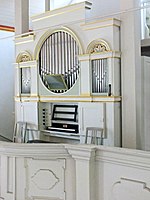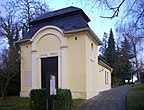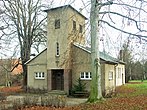Auenkirche (Markkleeberg)
The Auenkirche in Markkleeberg is the parish church of the Evangelical Lutheran Auenkirchgemeinde Markkleeberg-Ost with the associated Leipzig districts of Dösen and Dölitz . Until the union of Markkleeberg with Oetzsch and Gautzsch in 1934 to form the town of Markkleeberg, it was the village church of Markkleeberg, which was initially called Cleeberg. It is the oldest building in the town of Markkleeberg and is a listed building .
location
In Markkleeberg, a large district town in the Leipzig district in the Free State of Saxony , the church is located on the western edge of the Markkleeberg-Ost district on Kirchstrasse. Together with the rectory, the castle and its gatehouse, it forms a historical ensemble west of the Kleine Pleiße , the former course of the Pleiße . The church is located outside the built-up area of Markkleeberg-Ost or the old village of Markkleeberg.
history
According to archaeological excavations in 1997, the first church was built in the course of the settlement of German farmers in the 11th / 12th centuries. In the 19th century, a smaller, rectangular, towerless, Romanesque hall building with a straight east end, the south wall of which is still partially preserved. The church was first mentioned in writing in 1372. In the beginning, burials were also carried out in and around the church.
After the Reformation in 1555, the neighboring village of Dölitz was parish with the Meusdorf Vorwerk ; Lößnig joined in 1691 . After the church was almost completely destroyed by fire in 1612, it was re-consecrated in 1627 after being rebuilt, now with the baroque tower. Due to a lack of space, the church had to be expanded in 1654. This was done by adding the apse and adding galleries . Further space was created in 1744 by widening the north gallery, for which the extension that still exists today was built. The organ gallery was also built and a pulpit altar was purchased.
The church remained largely unscathed during fighting in the course of the Battle of Nations on October 16, 1813 around the castle and the Pleiße crossing.
In 1886 three colored glass windows were donated for the choir, which were destroyed in the Second World War, but were replaced in 1948 with donations. After it was destroyed by throwing stones, colorless lead glazing followed . Also in 1886, a heating system with a chimney that extended over the roof ridge was installed in the church, which was removed again after 1967. The pulpit and gallery structures, made of dark wood, also had to be removed due to wood damage. The south pore was not rebuilt and the church was now dominated by white.
In 1900 Lößnig had become an independent parish to which in 1939 the parts of Dölitz and Dosen belonging to the Auenkirche were assigned. The latter came back to the Auenkirch community in 1980.
After 1992, the Auenkirche was subjected to extensive renovation from the lining of the foundations to the renewal of the roof due to structural damage as a result of subsidence from the lignite mining industry that had been neighboring until then. In 1998 the late Gothic winged altar came into the church, and in 2000 the Kreuzbach organ followed.
architecture
The Auenkirche is a hall building about 20 meters long and 12 meters wide. Its axis deviates by +14 degrees from the exact easting . The choir has a five-eighth closing . On its south side, the church has four stepped buttresses . In the north, an extension for a gallery leads to a kink in the tiled roof. The gallery can only be reached from the outside via an arbor staircase (from 1908) adapted to the style of the church. Access to the church is through a porch on the west gable. The entrance to the sacristy is on the north side . The lancet windows are painted red, imitating porphyry. At the west end there is an octagonal baroque tower. It has a raised onion cap with a lantern and is covered with slate .
Furnishing
The interior of the church is essentially white. The barrel vault of the hall has a subtle coffered pattern.
The altar is a late Gothic winged altar by an unknown master and is dated to around 1500. It is on loan from the parish of Threna near Naunhof . Two days before the removal of the already remote in Threna the end of the 19th century from the church altar were in a slump, the figures in the upper rows of the side wings and two angels stolen, so that only the figures in the central shrine and in the lower rows Side wings are original. In the center of the central shrine stands Mary as a crescent moon Madonna , flanked by the apostles Simon Zelotes and Judas Thaddäus with the attributes of her martyrdom , a saw and a club. In the older church tradition, both are considered cousins of Jesus. The figures below are, with partly uncertain identification, Bartholomäus , Juliana , Andreas , the Evangelist Johannes , Dorothea , and Philip . The upper figures come partly from the earlier pulpit of the Auenkirche and from the left are the Evangelist Luke , Christ with the globe, the Apostle James (carved) and the Evangelist Mark . The panel paintings on the back of the wings show Anna Selbdritt and St. Laurentius .
The organ of the Auenkirche comes from the Borna organ building workshop of Urban Kreutzbach . It was built in 1841 for the Church of St. Martin in Elstertrebnitz . After the abandonment of this church after a fire, it came to the Auenkirche in 1999/2000 after restoration by the Bochmann company in Kohren-Sahlis . The organ with mechanical sliding chests has eleven stops on a manual and a pedal with pedal coupling . The predecessor of today's instruments were organs by Christian Ernst Friederici in 1749 and by Alfred Schmeisser in 1907–1966 . and then until 1999 a small Jehmlich organ from the Dresden Weinberg Church .
The bells of the Auenkirche were melted down in 1942 for armament purposes. Therefore, in 1958, new chilled cast iron bells were made by the Schilling & Lattermann company in Morgenröthe-Rautenkranz . After these were taken out of service due to material fatigue, the old bells were placed in front of the gatehouse.
additional
- The Pastor's Book of Saxony has recorded pastors at the Auenkirche since 1539.
- The cemetery of the Auenkirch parish has been located east of the village on Dösener Strasse for about 500 years, about 600 meters from the church.
- In 1934 a small aisle church was built in the park of the dozen property, which was initially parish to Lößnig. In 1984 she came to the Auenkirch parish and has been called Johanniskirche since 1994 . The Sunday church services of the congregation take place in it, alternating with the Auenkirche.
- A cooperation agreement has existed between the Auenkirch community and the sister church in Leipzig- Marienbrunn in various areas of community life since 2006
literature
- Auenkirchgemeinde (ed.): Auenkirche Markkleeberg - Markkleeberg Torhaus . 2002, 24 pp.
Web links
- History. In: Website of the Auenkirchgemeinde. Retrieved May 26, 2019 .
- Auenkirche. In: Website of the city of Markkleeberg. Retrieved May 26, 2019 .
- Auenkirche Markkleeberg-Ost. In: Evangelical Lutheran Church District Leipzig. Retrieved May 26, 2019 .
Individual evidence
- ↑ Oldest building in the city. In: leipzig.travel/de. Retrieved May 25, 2019 .
- ↑ List of cultural monuments in Markkleeberg , ID number 09256594
- ↑ Auenkirche Markkleeberg - organ disposition. In: Orgelstrasse Leipziger Land. Retrieved May 25, 2019 .
- ^ Klaus Gernhardt: Kreutzbach organ in the Auenkirche Markkleeberg-Ost. In: Outdooractive. Retrieved May 25, 2019 .
- ↑ Auenkirche Markkleeberg - Markkleeberg Torhaus , p. 11
- ↑ Auen pastor. In: Pastor's Book of Saxony. Retrieved February 23, 2020 .
Coordinates: 51 ° 16 ′ 38.9 " N , 12 ° 23 ′ 23.3" E







